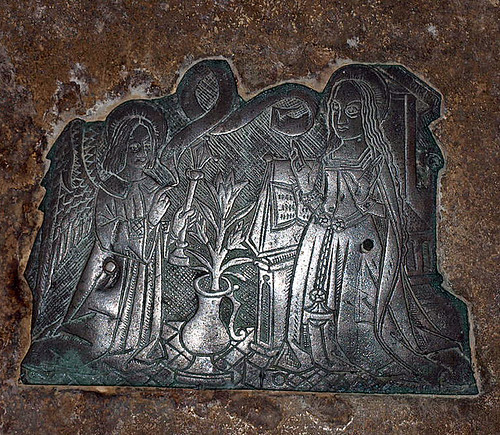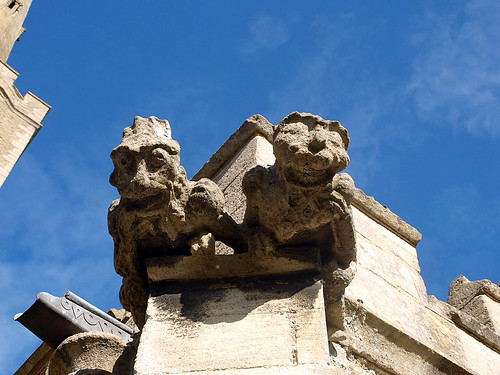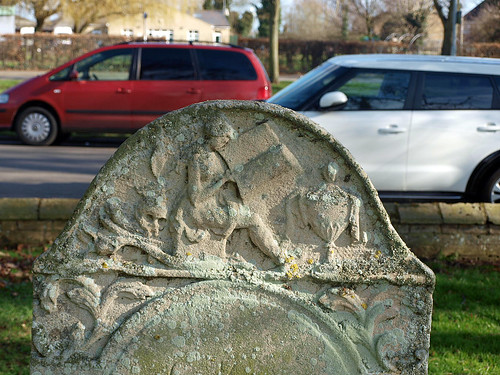After the disappointment of Victorian March, St Wendreda was a breath of fresh air - externally stunning, although the largely cleared churchyard is a tragedy - but the triumph here is the hammerbeam roof with its multitude of angels. Ignore that as obvious [difficult] and there's lots more of interest here; the interior repays as much as the exterior.
ST WENDREDA. At the S end of the town, in Church Street. A church almost entirely of the Dec and Perp styles, except for the N arcade which may be as early as 1300 and the chancel which is by W. Smith, 1872. The date of the Dec parts is indicated by a Papal indulgence of 1343 for those giving money to the new building. The Perp parts are of c. 1500 etc. (Date 1528 in the porch.) - Of the earlier period chiefly the lower parts of the W tower, the chancel arch, and the S arcade. The latter differs only in details from the N arcade. Both sides have five bays with octagonal piers. But the N capitals are more broadly moulded and the arches are triple-chamfered. The S arches are double-chamfered. On the N side the W bay was cut into, when the tower was built, on the S side there is a narrower full bay instead. The W tower has a gorgeous three-light W window with flowing tracery and a tall arch towards the nave. Below the W window a narrow N-S passage runs through the tower which reduces the depth of the space inside considerably. The Perp additions are sumptuous throughout. The aisles were renewed, with quatrefoil bases and battlements, and the N aisle received quatrefoil decoration in the battlements as well. A S porch was added with three-light openings, and a clerestory of flint with some flushwork decoration and brick window voussoirs. Inside, in connexion with this, a new roof was made, the most splendid timber roof of Cambridgeshire. It is a double hammerbeam roof and has figures of angels with spread-out wings in three tiers, at the corbels supporting the hammerbeam shafts, and at the ends of both hammerbeams (cf. Earl Stonham and Woolpit, Suffolk, and Knapton, Norfolk). - COMMUNION RAIL. Remains at W end of S aisle; C18. - PLATE. Chalice of 1752; Paten of 1703. - MONUMENTS. Brass to Andrew Dredeman d 1501 and his wife; 16 in. figures; in the nave floor. - Brass to Anthony Hansard d 1507 and his wife 5 kneeling figures with scrolls leading up to an Annunciation; coat of arms below; S aisle.
The old church was built about the middle of the 14th century as a chapelry of Doddington, and given the rare dedication of St Wendreda, an obscure Saxon saint of whom little is known, but whose relics are said to have been taken in a golden shrine, at the request of King Ethelred, from here to Ely. Fine battlements adorn the walls of this church, except for the new gabled chancel. The parapets of the 15th century aisles have quatrefoil tracery, and a band of quatrefoils runs round the plinth of the aisles and the old south porch, which has big windows, stone seats, a gable cross, and a stoup. There are grotesque gargoyles, and by some of the windows are human and animal heads, one of a woman in horned headdress. The sanctus bell still rings in the bellcot on the eastern gable of the nave, which has a striking 15th century clerestory of nine windows on each side, richly patterned in flint and stone. Crowning it all is a fine tower of about 1400, from which soars a graceful spire with canopied lights. The tower stands on two open arches with a vaulted passage between them, preserving a right-of-way existing here before the tower was built.
The medieval windows which light the fine interior are set in walls carved with arches at the top of which are human figures and angels. Lofty arcades divide the nave and aisles, the north aisle 600 years old and the south side 500. Exceedingly lofty, dwarfing the arcades, are the arches of the tower and chancel, the tower arch having a good Jacobean ringer’s gallery halfway up.
The great glory of the church is the magnificent double hammerbeam roof, whose equal it would be hard to find. It is all richly carved by 15th century craftsmen, with an amazing array of angels hovering over the nave from the arches and the hammerbeams, as well as from the corbels, which support saints standing in niches between the clerestory windows. There are nearly 200 angels in this heavenly host, all with outstretched wings, some with musical instruments, some with shields, and others with emblems of the Passion.
It is thought that William Dredenian, who died in 1503, gave this lovely roof, and two small brass portraits in the floor of the nave, now very worn, are believed to be of him and his wife. Under the tower is another brass with 16th century kneeling figures of Antony Hansart in armour and tabard, his feet gone, his wife in kennel headdress and girdled gown, their small daughter without a head. Below them is their shield, and above them is a striking and unusual Annunciation showing the Madonna kneeling at a desk, the Archangel Gabriel kneeling before her, and a vase of lilies between them.
There is an ancient font, and a modern pulpit with a vine border and figures of the Good Shepherd and the Four Evangelists. A richly coloured window of the south aisle has St Michael, St Etheldreda with her abbey at her feet, and St Wendreda holding her church. The most striking of the windows has a setting of seas and mountains, and a child with a bunch of flowers looking into the sky, where Our Lord is receiving two men at the gate of Heaven. A stone by the chancel door marks the grave of John Wyldboar, who lived through the hundred years from the middle of the reign of Charles Stuart.
Flickr.



No comments:
Post a Comment